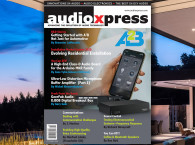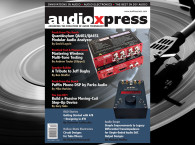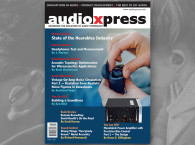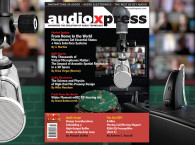 audioXpress November 2020 is now available and includes our most comprehensive DSP Market Update. Exploring both products and applications for Real-Time DSP, Edge Processing, and Artificial Intelligence, this special report from J. Martins and Mike Klasco will allow a broad perspective on the topic -- valuable to anyone working on audio designs.
audioXpress November 2020 is now available and includes our most comprehensive DSP Market Update. Exploring both products and applications for Real-Time DSP, Edge Processing, and Artificial Intelligence, this special report from J. Martins and Mike Klasco will allow a broad perspective on the topic -- valuable to anyone working on audio designs.
This year’s DSP market update highlights solutions and platforms that are now able to run extremely intense computational requirements in real time, as required by consumer applications, such as voice detection and acoustics optimizations. Increasingly, these platforms are evolving in large scale, targeting the ability to run artificial intelligence inference directly on-device. Solutions from Klippel, Waves, DSP Concepts, Syntiant, Oxford Digital, Analog Devices, Cadence, CEVA, and many other essential technology providers are discussed.
And to complement this wider perspective, Youval Nachum, CEVA’s Senior Product Marketing Manager, writes about "The Evolution of Audio DSPs," discussing how DSP technology has evolved, its impact on the user experience, and what the future of DSP has in store for us.
Following up on the two Communication articles published in audioXpress October 2020, Hans W. Gierlich, from HEAD acoustics GmbH, a top expert in his field, contributed a great overview article about "Testing and Optimizing Strategies for Conference Terminal Equipment." With most company employees working from home and the trend toward decentralized organizations and remote collaborations, where webinar and conferencing services are the new way of communication, this a timely topic. As Gierlich explains, "Once these communication solutions are adopted, we all have the same problems: The speech transmission quality varies. Sometimes it is so bad that good communication is not possible. But the reasons for this are complex. This article addresses how to evaluate and determine strategies for these challenges."
This edition of audioXpress also brings another test and measurement focused review from Stuart Yaniger. This time, Yaniger had the chance to try out and objectively evaluate the latest Earthworks M23R Measurement Microphone. The M23R is the latest omnidirectional model in Earthworks' infinitely matched series of measurement microphones. It is designed to be an affordable reference solution, delivering an IEC 61672 Class 1 frequency response before applying any equalization. And Yaniger discovered why this is another valuable addition to Earthworks' already strong portfolio and certainly a great solution for anyone who needs a microphone with accurate and flat response, good polar pattern, low distortion, and for its size, very low noise and high output.
This edition also offers another great Practical Test & Measurement article from Dan Knighten (Audio Precision), on "What to Measure for Quality Control of Audio Devices." In this article, he focuses on the practical question of quality control of audio devices, with an emphasis on manufacturing test strategies and objectives. He also shares what measurements reveal about the device under test, offers suggestions for specific measurements and provides techniques for various devices and scenarios.
We know many audioXpress readers are going to be following Brewster LaMacchia's series of articles about Getting Started with Automotive Audio Bus A2B (not just for automotive). In Part 2 of this series, LaMacchia writes about "Understanding A2B Features," and he examines how certain optimizations for the automotive applications must be accounted for when targeting broader audio applications. He also includes a look at analog phantom power and how A2B provides that feature in a digital system.
audioXpress November also offers the conclusion of an advanced DIY audio project that we know generated great interest among our readers. In "Ultra-Low Distortion Microphone Buffer Amplifier (Part 2)," Michel Nieuwenhuizen completes his microphone buffer amplifier that avoids most of the problems found in existing buffers. The circuit is shown and detailed in this second part, and the author also shows the results of simulations and measurements. Nieuwenhuizen also compares the performance of the circuit with that found in many Chinese condenser microphones (the “Schoeps” based circuit).
 With the title "Simple Improvements to Legacy Audio DAC Output Interfaces Using Op-Amps," Michael Steffes offers an in-depth perspective for audio electronic designers in his Audio Scope column. This month's article discusses how to achieve improved performance out of audio digital-to-analog converters by choosing different resistors.
With the title "Simple Improvements to Legacy Audio DAC Output Interfaces Using Op-Amps," Michael Steffes offers an in-depth perspective for audio electronic designers in his Audio Scope column. This month's article discusses how to achieve improved performance out of audio digital-to-analog converters by choosing different resistors.
In his Sound Control article, Richard Honeycutt discusses Electroacoustical Testing exploring Time-Domain and Distortion topics in greater detail. The article expands on the previous edition offering an overview of essential knowledge to measure the performance of live-sound electroacoustical systems.
Subscribing to the digital online version allows immediate access at: www.audioxpress.com/page/audioXpress-Subscription-Services.html
If you wish to buy a single printed issue or the complete audioXpress archive on USB, from 2000 to 2020 (yes, including the latest issue), just visit our online shop at www.cc-webshop.com
Don't miss out, get your copy of audioXpress right now at www.gotomyxpress.com

- on Magazine News
- News
More Digital Signal Processing and Better Audio in audioXpress November 2020
October 9 2020, 10:10
This audioXpress November 2020 edition explores the latest trends in digital signal processing (DSP) and how it applies to all audio applications, now increasing in power thanks to cutting-edge artificial intelligence running on devices. In this issue, you will also learn how to "Test and Optimize Strategies for Conference Terminal Equipment," "What to Measure for Quality Control of Audio Devices," and more about Automotive Audio Bus A2B. Stuart Yaniger reviews the latest Earthworks M23R Measurement Microphone, and you can read articles about acoustics, audio electronics and the best in DIY audio from our monthly columnists.





